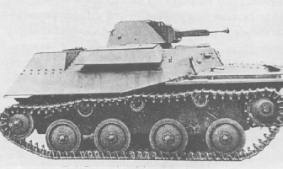
|
| Victory Points |
Armour | Start | Start | End | End | ||
| Front | Side | Rear | Month | Year | Month | Year | |
| 3 | 3 | 1 | 1 | 1 | 41 | 12 | 41 |
| T-40 Light Amphibious Tank | ||||||||||||||||||||
| RANGE | 1 | 2 | 3 | 4 | 5 | 6 | 7 | 8 | 9 | 10 | 11 | 12 | 13 | 14 | 15 | 16 | 17 | 18 | 19 | 20 |
| HARD | 3 | 1 | . | . | . | . | . | . | . | . | . | . | . | . | . | . | . | . | . | . |
| SOFT | 5 | 3 | 2 | . | . | . | . | . | . | . | . | . | . | . | . | . | . | . | . | . |

|
T-40 Light Amphibious Tank
|
Specification |
|
When the shortcomings of the T-37 / T-38 light tanks were recognized attempts were made to produce more viable successors.Production was assigned to factories normally producing automobiles.The two-man T-40 was a simple design and made extensive use of automobile components whenever possible including the engine and transmission.Early T-40's were armed with a 12.7mm heavy machine gun , later models had a 20mm cannon. The most noticeable feature of the T-40 was its bulky boat-shaped hull produced by two flotation tanks which kept the vehicle afloat in the water , while a propeller at the rear provided propulsion.The engine was on the right hand side of the welded hull.The first T-40s were used during the latter stages of the Winter War with Finland.Their thin armour drew criticism as the vehicles could be penetrated even by anti-tank rifles issued to Finnish infantry units.The T-40A had more armour (the hull outline was altered) and the T-40S intended to be introduced in 1942 was even better protected.However the extra weight involved meant that the T-40S lost its amphibious capability.As a result the whole light amphibious tank concept was scrapped and production concentrated on the Light Tank T-60.Most T-40s in service at the time of the German invasion were destroyed or captured in the vast encirclements of 1941. |